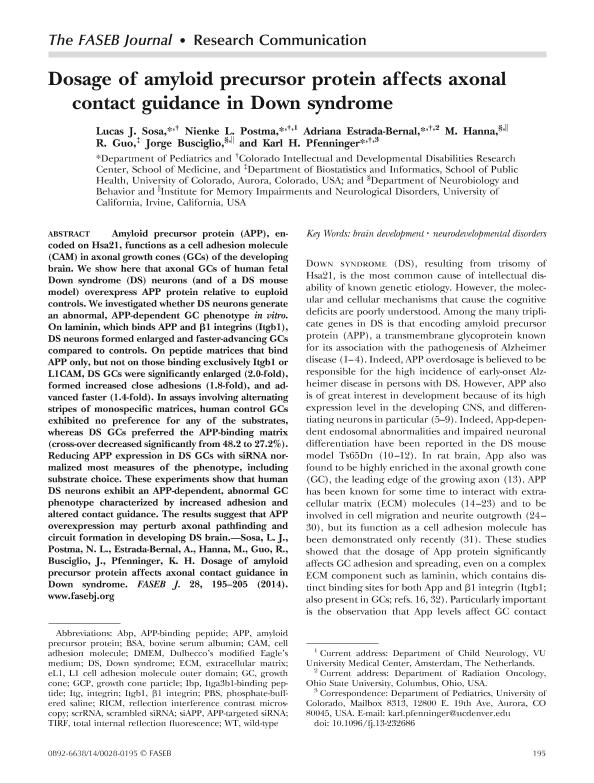Artículo
Dosage of amyloid precursor protein affects axonal contact guidance in Down syndrome
Sosa, Lucas Javier ; Postma, Nienke L.; Estrada-Bernal, Adriana; Hanna, M.; Guo, R.; Busciglio, Jorge; Pfenninger, Karl H.
; Postma, Nienke L.; Estrada-Bernal, Adriana; Hanna, M.; Guo, R.; Busciglio, Jorge; Pfenninger, Karl H.
 ; Postma, Nienke L.; Estrada-Bernal, Adriana; Hanna, M.; Guo, R.; Busciglio, Jorge; Pfenninger, Karl H.
; Postma, Nienke L.; Estrada-Bernal, Adriana; Hanna, M.; Guo, R.; Busciglio, Jorge; Pfenninger, Karl H.
Fecha de publicación:
01/2014
Editorial:
Federation of American Societies for Experimental Biology
Revista:
FASEB Journal
ISSN:
0892-6638
e-ISSN:
1530-6860
Idioma:
Inglés
Tipo de recurso:
Artículo publicado
Clasificación temática:
Resumen
Amyloid precursor protein (APP), encoded on Hsa21, functions as a cell adhesion molecule (CAM) in axonal growth cones (GCs) of the developing brain. We show here that axonal GCs of human fetal Down syndrome (DS) neurons (and of a DS mouse model) overexpress APP protein relative to euploid controls. We investigated whether DS neurons generate an abnormal, APP-dependent GC phenotype in vitro. On laminin, which binds APP and 1 integrins (Itgb1), DS neurons formed enlarged and faster-advancing GCs compared to controls. On peptide matrices that bind APP only, but not on those binding exclusively Itgb1 or L1CAM, DS GCs were significantly enlarged (2.0-fold), formed increased close adhesions (1.8-fold), and advanced faster (1.4-fold). In assays involving alternating stripes of monospecific matrices, human control GCs exhibited no preference for any of the substrates, whereas DS GCs preferred the APP-binding matrix (cross-over decreased significantly from 48.2 to 27.2%). Reducing APP expression in DS GCs with siRNA normalized most measures of the phenotype, including substrate choice. These experiments show that human DS neurons exhibit an APP-dependent, abnormal GC phenotype characterized by increased adhesion and altered contact guidance. The results suggest that APP overexpression may perturb axonal pathfinding and circuit formation in developing DS brain.
Palabras clave:
BRAIN DEVELOPMENT
,
NEURODEVELOPMENTAL DISORDERS
Archivos asociados
Licencia
Identificadores
Colecciones
Articulos(CIQUIBIC)
Articulos de CENTRO DE INVEST.EN QCA.BIOL.DE CORDOBA (P)
Articulos de CENTRO DE INVEST.EN QCA.BIOL.DE CORDOBA (P)
Citación
Sosa, Lucas Javier; Postma, Nienke L.; Estrada-Bernal, Adriana; Hanna, M.; Guo, R.; et al.; Dosage of amyloid precursor protein affects axonal contact guidance in Down syndrome; Federation of American Societies for Experimental Biology; FASEB Journal; 28; 1; 1-2014; 195-205
Compartir
Altmétricas



